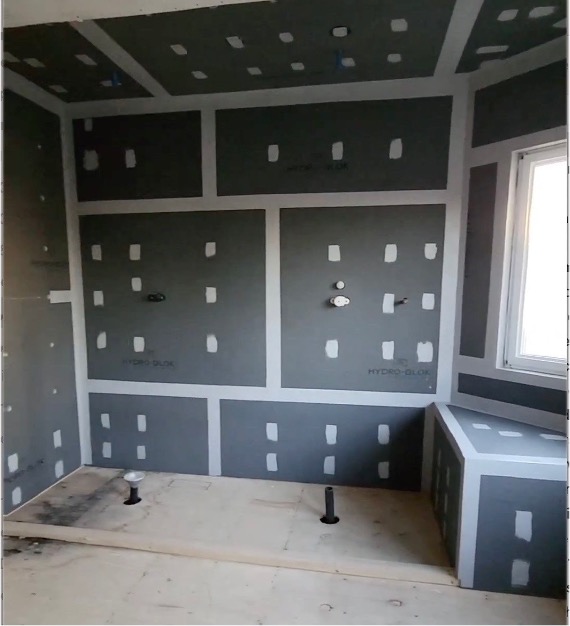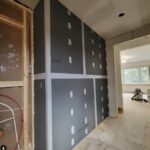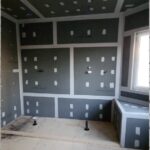When it comes to selecting the right tile backer board for your project, there are two main options: cement backer board and foam backer board. Cement backer board is a more traditional material used in tiling projects, while foam backer board is a newer product with unique benefits. Both materials have advantages and disadvantages that should be considered when choosing the best option for your needs.
What is Cement Backer Board?
Cement backer board, or tile backer board, is a building material made from cement and fiberglass mesh. It is typically used as an underlayment for flooring, countertops, and walls covered with tile or other waterproof materials. Cement backer board is solid and durable and can help protect the subfloor from moisture damage. It also provides a stable base for tiles to adhere to, helps reduce noise transfer between floors, and eliminates potential cracking in the finish layer caused by inconsistent surfaces. However, cement backer boards can be heavy and difficult to work with due to their dense composition.
What is Foam Backer Board?
Foam backer board is lighter than cement-based boards and typically made from polystyrene or polyurethane foam. It is designed to provide insulation and cushioning for tile and other waterproof coverings. Foam backer boards can also level uneven surfaces before installation, making it easier to achieve a professional finish. Additionally, foam backer board is far easier to cut than cement-based boards, which makes it quicker and simpler to install. However, foam backer board provides less structural support than cement-based boards due to their lightweight nature. As such, it may require additional reinforcement in specific applications.
The Disadvantages of Using Cement Backer Board
While cement board is a commonly used building material with several benefits, it also has disadvantages. Here are a few drawbacks of using cement board:
- Weight: Cement board is heavier than other building materials such as foam board. This weight can make handling and installation more challenging, requiring more effort and potentially more workers.
- Installation Complexity: Cement board installation can be more complex than other materials. It typically requires special tools and techniques for cutting and fastening. The process may be more time-consuming, particularly when compared to lightweight alternatives.
- Brittle Nature: Cement board is relatively brittle and prone to cracking if improperly handled or installed. It can be more difficult to cut accurately, and excessive force or improper handling during installation can lead to breakage. Special care must be taken to avoid damaging the board.
- Dust and Debris: Cutting or working with cement boards generates dust and debris, which can be a respiratory irritant. It is important to wear appropriate personal protective equipment (PPE), such as a dust mask and safety glasses when handling and cutting cement boards to minimize health risks.
- Moisture Absorption: While cement board is moisture-resistant, it can still absorb water if exposed to prolonged moisture. If not properly sealed or if water seeps through joints or cracks, it can lead to moisture-related issues such as mold or deterioration.
- Limited Insulation: Cement board itself does not provide significant insulation properties. It is a neutral material in terms of thermal resistance and does not contribute to energy efficiency or insulation.
It is essential to assess the specific needs of your project, consider the advantages and disadvantages, and evaluate the suitability of cement board to other available materials. Consulting with professionals or local experts can help you make an informed decision based on your project’s requirements.
The Advantages of Using Foam Backer Board
Using foam backer boards in various construction applications offers several advantages. Here are some of the key benefits:
- Insulation: Foam backer board is an excellent insulator, providing thermal resistance to help maintain comfortable indoor temperatures. It helps prevent heat transfer, reducing energy consumption and lowering heating and cooling costs.
- Moisture resistance: Foam backer board is moisture-resistant, making it an ideal choice for areas prone to moisture exposure, such as bathrooms, kitchens, and basements. It does not absorb water, preventing mold, mildew, and rot from developing.
- Lightweight: Foam backer board is lightweight compared to other traditional construction materials. This feature makes it easier to handle and transport, reducing the physical strain on workers during installation.
- Easy installation: Foam backer board is relatively easy to install. It can be easily cut into desired sizes and shapes using basic tools. The lightweight nature of foam backer board simplifies the installation process, saving time and effort.
- Stability: Foam backer board offers dimensional stability, meaning it does not expand or contract significantly with temperature and humidity changes. This stability ensures that the installed materials, such as tiles or other finishes, remain intact and minimize the risk of cracks or damage.
- Soundproofing: Due to its composition and structure, foam backer board provides some level of sound insulation. It helps reduce noise transmission from one area to another, making it beneficial for applications where soundproofing is desired, such as walls between rooms or floors in multi-story buildings.
- Compatibility with tile installations: Foam backer board is commonly used as an underlayment for tile installations. It provides a stable and flat surface, enhancing the longevity of tile installations by minimizing movement and flexing.
- Cost-effective: Foam backer board is often cost-effective compared to other alternatives. Its ease of installation reduces labor costs, while its insulating properties can contribute to long-term energy savings. Additionally, its resistance to moisture and durability can result in reduced maintenance and repair expenses over time.
While foam backer board offers many advantages, choosing the appropriate type and thickness is important based on the specific application and local building codes.

How do you cut foam backer boards?
Basic tools can easily cut foam backer boards into desired sizes and shapes. Depending on the thickness of the board, a utility knife or circular saw may be used. When using a utility knife, begin by scoring the surface of the foam board in multiple passes, then cut through the material along the score lines. Use a circular saw to make straight, accurate cuts for thicker materials. Secure the foam board to a workbench or table to ensure cutting stability. After cutting, sand down rough spots for a smooth finish before installation. Wear protective gear such as safety glasses and gloves when working with power tools to protect against dust particles and sharp edges.
To cut foam backer boards, you can follow these general steps:
- Gather the necessary tools: You will need a utility knife, a straight edge or ruler, and a marker or pencil for marking the cutting line.
- Measure and mark the cutting line: Use a straight edge or ruler to measure and mark the desired cutting line on the foam backer board. Make sure your measurements are accurate.
- Score the board: Place the straight edge along the marked cutting line, and use a utility knife to score the foam backer board. Apply firm, steady pressure while making multiple passes along the same line. The goal is to cut through the top surface of the board without cutting all the way through.
- Snap the board: Once you have scored the foam backer board, you can snap it along the scored line. Place the board on a flat surface, align the scored line with the edge of the surface, and gently press down on the overhanging portion of the board. The board should break cleanly along the scored line.
- Cut through the remaining thickness: If the foam backer board is thicker than the score line depth, you must cut through the remaining thickness. Continue using the utility knife to make additional passes along the scored line until you have cut through the entire thickness of the board.
- Smooth the cut edge: You may notice some rough or jagged edges after cutting the foam backer board. Use a utility knife or sandpaper to smooth out imperfections along the cut edge.
Remember to follow proper safety precautions when using a utility knife, such as keeping your fingers clear of the blade and working on a stable surface. Additionally, it’s always a good idea to refer to the manufacturer’s instructions or guidelines for cutting specific types of foam backer boards, as different products may have slight variations in cutting techniques.
What is foam backer board used for?
Foam backer board, also known as foam board or foam panel, has a variety of uses in construction and remodeling projects. Some typical applications of foam backer board include:
- Insulation: Foam backer board is primarily used as insulation in walls, roofs, and floors. It provides thermal resistance, helping to prevent heat transfer and maintain comfortable indoor temperatures. It is commonly used in residential and commercial buildings to improve energy efficiency.
- Underlayment for Tile Installations: Foam backer board is often used as an underlayment for tile installations. It provides a stable and flat surface for tile adhesion. It helps prevent movement, flexing, and cracking of tiles, enhancing the longevity of the tiled surface.
- Soundproofing: Due to its composition and structure, foam backer board offers some level of sound insulation. It helps reduce noise transmission between rooms or floors, making it beneficial for soundproofing applications.
- Moisture Barrier: Foam backer board has inherent moisture-resistant properties. It does not absorb water and can act as a moisture barrier, helping to prevent water penetration and related issues such as mold and rot. It is commonly used in areas prone to moisture, such as basements, bathrooms, and kitchens.
- Void Filling and Structural Support: Foam backer boards can fill voids and provide structural support in construction projects. It can be cut and shaped to fit specific spaces and used to fill gaps or provide support behind walls, under floors, or in other areas where additional stability is required.
- Craft and DIY Projects: Foam backer board is also used in various craft and DIY projects. Its lightweight nature and ease of cutting make it suitable for creating prototypes, scale models, and other creative applications.
It’s important to note that foam backer board comes in different types and thicknesses, each with specific applications and limitations. The foam backer board type and thickness should be based on the specific project requirements and local building codes.
Using HYDRO-BLOK Foam Boards and Building Panels
Hydro-Blok foam boards and building panels are specialized products designed for waterproofing and tile installation applications in wet areas. Here’s some information about these products:
Hydro-Blok Foam Boards:
Hydro-Blok foam boards are high-density, closed-cell extruded polystyrene (XPS) foam boards specifically engineered for waterproofing and tile backing purposes. They offer several advantages in wet area applications:
- Waterproofing: Hydro-Blok foam boards are inherently waterproof, providing a barrier against water penetration. This feature makes them suitable for showers, steam rooms, saunas, and other wet environments.
- Tile Backing: These foam boards serve as an ideal substrate for tile installations. They provide a stable and flat surface, ensuring proper tile adhesion and preventing movement or flexing that can lead to tile cracking or failure.
- Easy Installation: Hydro-Blok foam boards are lightweight, making them easy to handle and install. They can be cut to size using basic tools and adhered to the desired surface using compatible adhesives.
- Insulation: XPS foam boards offer thermal insulation properties, contributing to energy efficiency and maintaining comfortable temperatures in indoor spaces.
- Mold and Mildew Resistance: The closed-cell structure of Hydro-Blok foam boards makes them resistant to mold and mildew growth, which helps to maintain a clean and hygienic environment in wet areas.
Hydro-Blok Building Panels:
Hydro-Blok building panels are specifically designed for construction applications requiring waterproof, lightweight, and durable material. They offer similar benefits to Hydro-Blok foam boards but are available in larger sizes and are suitable for a broader range of applications. Some key features include:
- Waterproofing: Hydro-Blok building panels provide an effective waterproofing solution for applications such as foundations, exterior walls, and below-grade areas.
- Strength and Durability: These panels are engineered to be structurally solid and durable, capable of withstanding significant loads and impacts.
- Insulation: Hydro-Blok building panels offer insulation properties, contributing to energy efficiency and thermal comfort.
- Versatility: The large panel sizes and flexibility of Hydro-Blok building panels make them suitable for various applications, including prefabricated walls, insulation panels, and architectural features.
It’s essential to note that Hydro-Blok foam boards and building panels are specific branded products, and it’s recommended to follow the manufacturer’s guidelines for installation and usage. Additionally, always ensure compliance with local building codes and regulations when using these products in construction projects.





Share This Article
Choose Your Platform: